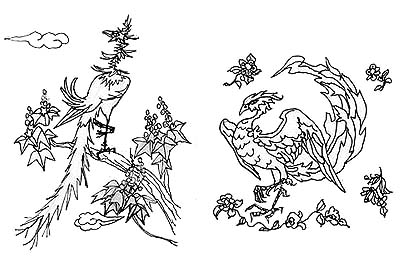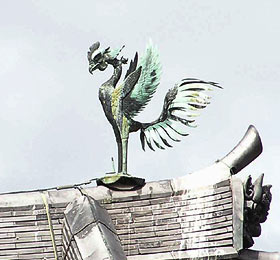|
||
 |
||
2@Ch: fenghuang. A phoenix. An auspicious, imaginary Chinese bird. A symbol of the southern direction and one of the guardian animals of the four directions *shishin l_. Images of the phoenix often were placed on the southern side of tower gates,
Imperial buildings, and Buddhist temples. The phoenix myth dates at least to the Shang dynasty, and several early texts describe it perched in paulownia (Jp: kiri Λ) trees and eating bamboo leaves. Like the mythical *kirin κiΩ, the phoenix is a composite of several different creatures including the pheasant and peacock and also embodies both a male element, the hou P, and a female element, the ou . Its plumage is said to be five colored. The phoenix was a symbol of longevity and good fortune,appearing during times of prosperity and signaling the advent of good government. In later Taoist legends the phoenix was a vehicle of immortals that transports them to the Western Paradise.
The earliest depictions of the phoenix are found on walls of ancient Chinese and Korean tombs and in textile fragments. By the Ming dynasty (14c) the phoenix had achieved wide popularity, as seen in the painting by Lin Liang (Jp: Rin Ryou ΡΗ: early 16c) at Shoukokuji in Kyoto. In Japan, the phoenix was a favorite design motif in textiles, metal work, ceramics and architecture. It appeared as early as Kofun period metal work and on numerous *Shousouin ³q@ craft pieces. Polychrome wooden phoenixes are found in the canopies of Houryuuji *Kondou @²ΰ°, in Nara. Byoudouin *Hououdou ½@P° (1053) in Kyoto, is shaped like the bird in flight and topped with bronze phoenixes, perhaps a reference to the birds ability to carry one to the Western Paradise. Paintings of phoenixes roosting on paulownia tree were a speciality of *Kanouha λμh artists, but in this case they were emblematic of benevolent rule of the Tokugawa Ώμ family, whose crest was the paulownia.
The phoenix crest or hououmon PΆ appeared in the Heian and Kamakura periods. For example, the circular crest of the phoenix, paulownia, and bamboo was reserved for the emperor's ceremonial outer cape.

@
(C)2001 Japanese Architecture and Art Net Users System.@No reproduction or republication without written permission.
fΪΜeLXgEΚ^ECXgΘΗASΔΜRecΜ³f‘»E]ΪπΦΆά·B


